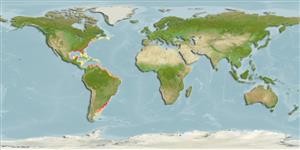Common names from other countries
Environment: milieu / climate zone / depth range / distribution range
Ecologia
marinhas; estuarina demersal; oceanódromo (Ref. 51243); intervalo de profundidade 10 - ? m. Subtropical; 46°N - 51°S
Western Atlantic: Nova Scotia (Ref. 7251) to Florida, Gulf of Mexico, the Antilles (uncommon), and the southern Caribbean coast; also from the Orinoco delta to Argentina.
Length at first maturity / Tamanho / Peso / Idade
Maturity: Lm 64.5, range 63 - ? cm
Max length : 170 cm TL macho/indeterminado; (Ref. 7251); common length : 50.0 cm TL macho/indeterminado; (Ref. 3702); peso máx. Publicado: 51.3 kg (Ref. 4699); Idade máx. registada: 43 anos (Ref. 7188)
Espinhos dorsais (total) : 11; Raios dorsais moles (total) : 19 - 22; Espinhos anais: 2; Raios anais moles: 5 - 7. Silvery grey to very dark, young with 4 or 5 black vertical bars on sides, disappearing with growth; pelvic and anal fins usually dark. Chin with 5 pores and 10 to 13 pairs of small barbels along median edges of lower jaws and subopercles, increasing in length posteriorly. Gas bladder with numerous lateral appendages interconnected in a complicated pattern in adult. Sagitta semicircular and moderately thin (Ref 51721).
Found usually over sand and sandy mud bottoms in coastal waters, especially in areas with large river runoffs. Juveniles often enter estuaries. Feeds mainly on crustaceans, mollusks and fishes.
Robins, C.R. and G.C. Ray, 1986. A field guide to Atlantic coast fishes of North America. Houghton Mifflin Company, Boston, U.S.A. 354 p. (Ref. 7251)
Categoria na Lista Vermelha da IUCN (Ref. 130435)
CITES (Ref. 128078)
Not Evaluated
Ameaça para o homem
Harmless
Utilização humana
Pescarias: espécies comerciais; peixe desportivo: sim; Aquário: Aquários públicos
Ferramentas
Relatórios especiais
Descarregue XML
Fontes da internet
Estimates based on models
Preferred temperature (Ref.
115969): 10.8 - 27.6, mean 23.5 (based on 326 cells).
Phylogenetic diversity index (Ref.
82804): PD
50 = 1.0000 [Uniqueness, from 0.5 = low to 2.0 = high].
Bayesian length-weight: a=0.00832 (0.00757 - 0.00914), b=3.08 (3.05 - 3.11), in cm Total Length, based on LWR estimates for this species (Ref.
93245).
Nível Trófico (Ref.
69278): 3.4 ±0.5 se; based on diet studies.
Resiliência (Ref.
120179): Médio, tempo mínimo de duplicação da população 1,4 - 4,4 anos (K=0.17; tm=3-5; tmax=43).
Fishing Vulnerability (Ref.
59153): High vulnerability (60 of 100).
Climate Vulnerability (Ref.
125649): Moderate to high vulnerability (54 of 100).
